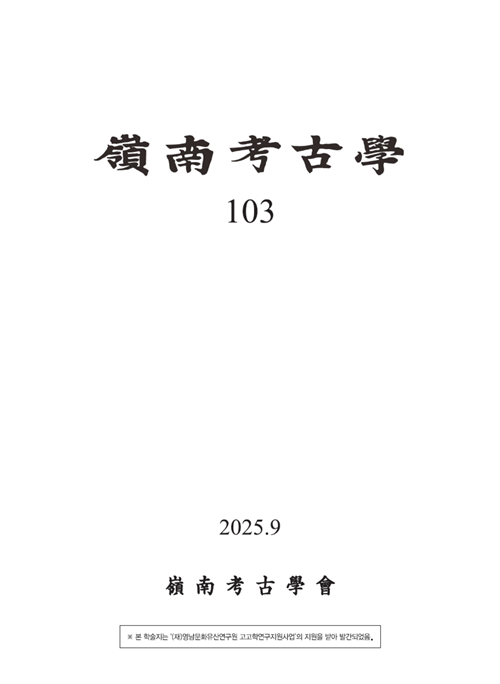- 영문명
- Core and Periphery in the Bihwagaya as Reflected in Burial Mound Construction Techniques
- 발행기관
- 영남고고학회
- 저자명
- 정인태(Intae Jung)
- 간행물 정보
- 『영남고고학』제103호, 141~182쪽, 전체 42쪽
- 주제분류
- 인문학 > 역사학
- 파일형태
- 발행일자
- 2025.09.30
7,840원
구매일시로부터 72시간 이내에 다운로드 가능합니다.
이 학술논문 정보는 (주)교보문고와 각 발행기관 사이에 저작물 이용 계약이 체결된 것으로, 교보문고를 통해 제공되고 있습니다.

국문 초록
고분 축조로 본 비화가야는 크게 두 세력으로 나뉘는데, 계성고분군 축조집단과 교동·송현동고분군 축조집단이다. 계성고분군은 대형 봉토분이 능선에 열상 배치되고 분형은 타원형, 호석은 2중이다. 봉토 성토는순차성토, 석축렬을 구획재로 한다. 묘제는 격벽으로 주부곽을 구분한 수혈식으로 6세기 이후 추가장이 있는횡구식으로 변화한다. 수혈식석곽묘의 벽석은 주로 천석을 사용하였고 목재와 횡목을 보조시설로 사용하였다. 두향은 북향이다. 계성고분군보다 하위의 주변 고분군으로는 영산고분군, 우강리고분군이 있다.
반면 교동·송현동고분군은 대형 봉토분과 주변 중소형 봉토분이 각각의 군집을 이룬다. 분형은 원형, 눈썹형 주구가 있고 호석은 일렬이며 부분 2단을 보이는 것이 있다. 봉토 성토는 동시성토, 분할성토 등이 확인되고 구획재로 이랑식 구획, 점토블럭, 표지석, 석렬, 목주 등 다양하게 나타난다. 묘제는 부곽이 없이 한쪽에입구를 두는 횡구식이다. 벽석은 종평적 또는 수적하며 목주와 횡목을 보조시설로 사용하였다. 두향은 남향이다. 입구부에 동물뼈 매납에 따른 제의 흔적이 확인된다. 교동·송현동고분군보다 하위의 주변 고분군으로는 우천리고분군, 초곡리고분군, 주매리 마산터고분군 및 청도지역의 성곡리·봉기리·송서리고분군이있다. 우강리고분군은 초기 계성고분군의 하위 고분군에서 후기는 교동·송현동고분군의 영향을 받아 고분을 축조하였다.
고분 축조기법과 매장의례, 동일 토기문화권을 근거로 비화가야는 현재 행정구역으로 창녕군 창녕읍, 계성면, 영산면, 대합면, 도천면, 이방면과 청도군 풍각면이다. 또 신라 복속 시기는 송Ⅰ-6·7호분, 교Ⅰ-12호분이축조되는 6세기 전엽 이후 ~ 문헌기록의 하주 설치 및 진흥왕척경비가 세워지는 6세기 중엽 사이로 본다.
영문 초록
The burial mound builders of Bihwagaya can be broadly divided into two groups: the builders of the Gyesong Tomb Group and those of the Gyodong-Songhyeon-dong Tomb Groups. The Gyesong Tomb Group features large earthen mounds arranged in linear patterns along ridge lines. The mounds are typically oval in shape and encircled by double-layered stone settings (hoseok). The construction of the mound fill follows a sequential layering method, with partitioning achieved through stone alignment structures. The burial system begins as a pit-style tomb with compartment walls dividing the main and subsidiary burial chambers, and transitions into a horizontal entrance style (hoenggushik) with secondary burials after the 6th century. For the stone-lined pit graves, natural flat stones (cheonseok) were primarily used, along with wooden elements and horizontal timbers as auxiliary structures. The tomb orientation is generally north-facing. Subordinate to the Gyesong group are peripheral tomb clusters such as the Yeongsan and Ugang-ri tomb groups.
In contrast, the Gyodong and Songhyeon-dong Tomb Groups consist of clusters formed by both large and small to medium-sized mounds. The tombs are circular in shape, often accompanied by eyebrow-shaped moats (jugus). The stone settings are aligned in a single row, with some mounds showing a two-tiered structure. The mound fill method includes simultaneous and segmented layering, with various partitioning techniques such as ridge-style divisions, clay blocks, marker stones, stone alignments, and wooden posts. The burial system is of the horizontal entrance type, typically with no subsidiary chamber, and features an entrance on one side. The walls of the burial chambers are constructed with horizontally or vertically laid stones, and wooden posts and horizontal beams are used as supplementary structural elements. The tomb orientation is south-facing. Traces of ritual activity, such as the burial of animal bones near the entrance, have been identified. Peripheral tomb clusters subordinate to the Gyodong and Songhyeon-dong groups include the Ucheon-ri, Chogok-ri, and Jumae-ri Masan site tomb groups, as well as the Seonggok-ri, Bonggi-ri, and Songseo-ri groups in the Cheongdo region. The Ugang-ri Tomb Group, initially subordinate to the Gyesong group, later came under the influence of the Gyodong and Songhyeon-dong groups in its later phase of mound construction.
Based on construction techniques, burial rituals, and shared pottery culture, the core region of Bihwagaya is considered to correspond to the current administrative areas of Changnyeong-eup, Gyesong-myeon, Yeongsan-myeon, Daehap-myeon, Docheon-myeon, and Ibang-myeon in Changnyeong County, as well as Punggak-myeon in Cheongdo County. The incorporation of Bihwagaya into the Silla state is thought to have occurred sometime between the early 6th century— when tombs such as SongI-6·7 and GyoI-12 were constructed and the mid-6th century, when Silla’s administrative expansion is documented through historical records and the erection of King Jinheung's boundary monuments.
목차
Ⅰ. 머리말
Ⅱ. 비화가야의 중심 고분군
Ⅲ. 비화가야의 주변 고분군
Ⅳ. 비화가야 고분 축조기법의 특징
Ⅴ. 비화가야의 중심과 주변
Ⅵ. 맺음말
키워드
해당간행물 수록 논문
참고문헌
교보eBook 첫 방문을 환영 합니다!

신규가입 혜택 지급이 완료 되었습니다.
바로 사용 가능한 교보e캐시 1,000원 (유효기간 7일)
지금 바로 교보eBook의 다양한 콘텐츠를 이용해 보세요!



